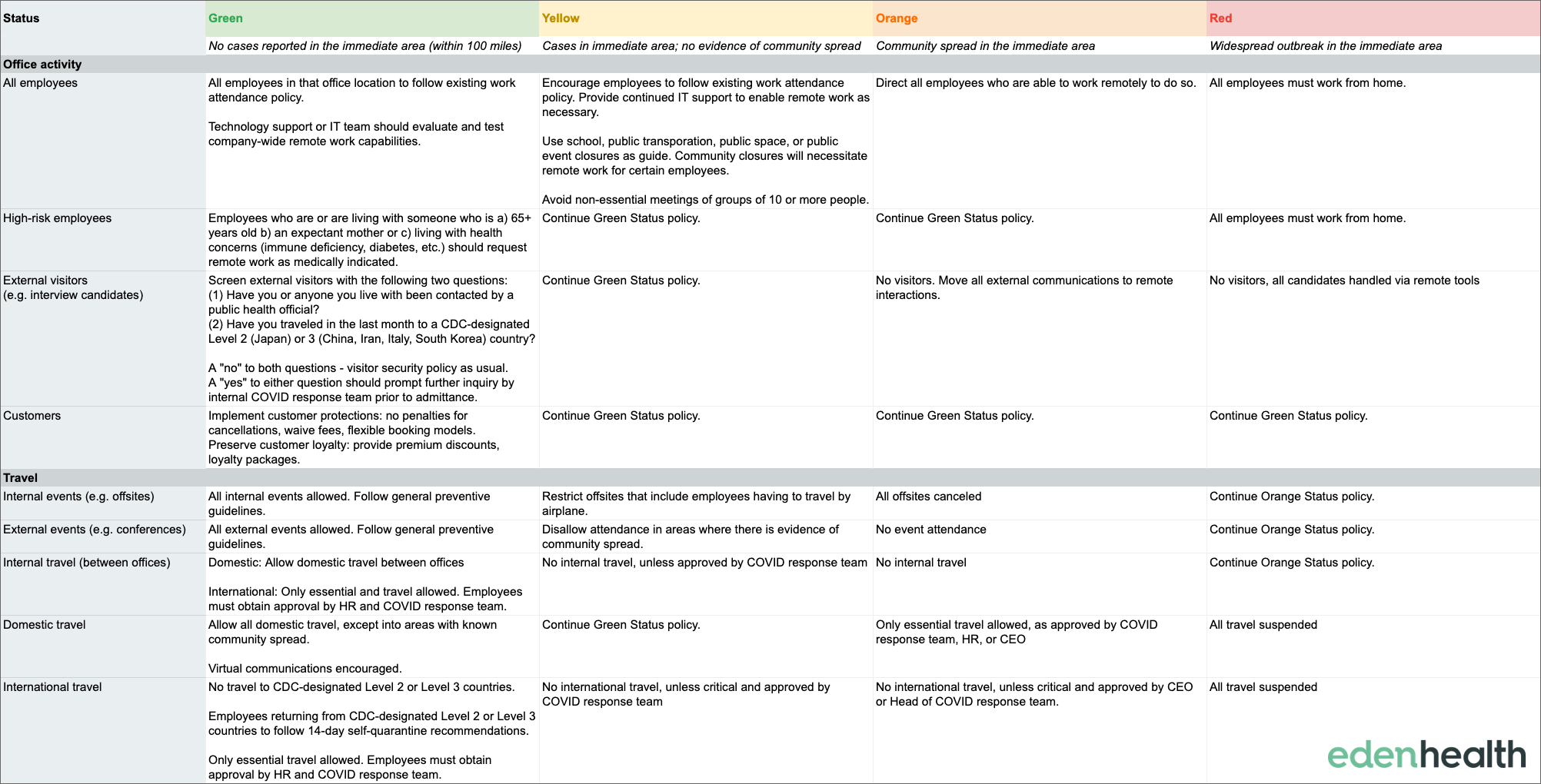As COVID-19 cases begin spreading in many countries including the United States, we recommend that all employers prepare for the impact of coronavirus within their communities and workplaces.
In this guide, we aim to provide easy-to-understand decision making frameworks for employers to prepare for the spread of the coronavirus outbreak.
We will cover:
- A list of key terms related to COVID-19
- A framework for making decisions based on the spread of COVID-19 in your area
- Development of a COVID response team and recommended precautions
- Next steps (with sample communications) in case of direct exposure or self-quarantine
We recognize that each organization has unique business and cultural needs, but we hope that this guide helps leaders think through scenarios as they relate to employees, families, customers, partners, and the community.
In addition to helping business leaders think through specific scenarios, we have also included sample materials that can be adapted for communication to employees in each of those scenarios.
The recommendations in this document derive from CDC and WHO guidelines, guidance from leading medical experts, and best practices from leading employers as of March 9, 2020. For the most up-to-date information and for public health guidelines, or if you would like to read public health or clinical information about the coronavirus outbreak, please visit https://www.cdc.gov/coronavirus/2019-ncov/index.html.
Key terms for COVID-19 response
In order to ensure clarity, it will be helpful to establish some common terms.
A confirmed case is an individual with laboratory-confirmed positive test for COVID-19.
A self-quarantine is a strategy to restrict the activities and movement of a person who has been exposed to the virus but has not necessarily tested positive. A self-quarantine should be 14 days long, as recommended by the CDC. Activities outside the home should be restricted, except to seek medical attention, in which case people should avoid using public transportation. In the event that someone cannot avoid roommates or family, people under self-quarantine should use their own bedroom, wear a face mask, and not share bedding, towels, or dishes.
Contact refers to direct contact with respiratory droplets from a confirmed case (e.g., being coughed on) or proximity within approximately 6 feet (2 meters) of a confirmed case for a prolonged period of time, such as attending a conference or sharing a workspace with a confirmed case.
Community spread is the transmission of the virus in the absence of relevant travel history or contact with a confirmed case.
Essential travel is travel that is absolutely necessary for the success of an individual, the company, or a customer. Businesses should consider the goal of the visit and whether or not it can be achieved by a team member already in the location or through remote communication technologies. The impact on the performance of the employee and the business should also be considered.
What employers should prepare now
Even if your employees are not directly impacted by COVID-19, we recommend that all employers plan thoroughly with an emphasis on concrete events that would trigger the implementation of new policies..
To view confirmed cases by country and by city/county, refer to the Coronavirus COVID-19 Global Cases Dashboard by Johns Hopkins CSSE.
Establish triggers that would cause updates to company policies
The following is a decision making framework that walks employers through when they should implement additional policies to protect their employees, employees’ families, customers, and partners.
Companies should make decisions based on the nature of their business and their risk preferences. Some companies will choose to enact stricter policies earlier than others. Additionally, you should stay up to date and in compliance with guidance from the government and the CDC.
To view the spreadsheet, click the image or click here (Google Docs).
Additionally, there is a blank template on the second sheet (direct link) you can use for your organization.
Establish internal COVID-19 response team
We recommend that businesses assemble a cross-functional COVID-19 response team to ensure that the business is prepared to deal with a range of outcomes by establishing decision makers and reinforcing internal knowledge sharing. This team can meet at varying frequencies, from twice a week to daily, depending on your business needs.
This response team should:
- Communicate COVID-19 related policies regularly and clearly.
- Leverage and distribute expert information to help provide clarity, reduce anxiety, and prevent the spread of misinformation.
- Prepare IT infrastructure to allow for productive work and test the communications approach that will facilitate remote work.
- Consider the impact of possible facility closures in the community. For example, school closures may prompt the need for employees to work remotely.
- Provide clear policies for business-related travel and conference attendance.
- Consider how your company can leverage its capabilities and expertise to contribute to community efforts regarding containment and care.
Communicate universal precautions to employees
While this is a time of high anxiety, we encourage organizational leaders to proceed with calm precaution, plan ahead, and communicate clearly as the situation develops. Here is an example email communication you can send to your employees.
Additional resource: Sample internal communication for base precautions.
Other examples:
- See “Policy & Communication Templates” in LifeLabs Learning COVID-19 Prep Doc
- See “Coronavirus Response Plans” from Public Coronavirus Company Communications
- Lattice COVID-19 Response Protocol
Establish best practices for productivity and performance
While this is outside the scope of this document, we would like to briefly mention that businesses should provide managers and employees with best practices for new workflows and business environments.
For example, companies may:
- Start preparing remote work capabilities and testing remote work readiness
- Train managers and teams about remote work best practices
- Create ways to boost and solidify customer satisfaction and loyalty
We encourage you to view these other resources that cover these topics in more detail:
- See “Transitioning to Work From Home” in LifeLabs Learning COVID-19 Prep Doc
- “8 Questions Employers Should Ask About Coronavirus” from Harvard Business Review
- “Resources for Companies Embracing Remote Work” from Gitlab
- OSHA Guidance on COVID-19 and Worker Safety from U.S. Dept of Labor
In the event of employee contact with COVID-19
If an employee tests positive for COVID-19 (a confirmed case):
In this case, the employee who tested positive will likely be placed into home-based or hospital-based quarantine, depending on the severity of their condition and need for supportive care.
A local, state, or national public health authority, such as the CDC, may contact your organization to suggest or impose next steps for individuals who were in contact with the confirmed case.
According to CDC guidance, if an employee is confirmed to have COVID-19, employers should inform fellow employees of their possible exposure to COVID-19 in the workplace while maintaining confidentiality of the employee’s health condition.
All employees sharing a workplace with the confirmed case for the previous 14 days will likely be required by public health officials to self-quarantine for the subsequent 14 days.
Actions to consider:
- Send a communication to your employees and customers in contact with the confirmed case as a directive to self-quarantine.
Additional resource: Sample internal communication in the case of an employee confirmed case - Provide technological support to self-quarantined employees to enable remote work.
- Perform a deep cleaning of the facilities where the employee worked.*
- Extend support resources for self-quarantined employees with concerns. Remind employees that they can use telehealth resources, such as Eden Health, if they are available.
- Prepare a communication to managers about how to manage performance and support stress and anxiety while working remotely (see above linked resources for details).
* At this time, there is no clear evidence that cleaning reduces the risk of spread, but added precautions demonstrate proactive diligence to employees, customers, and partners.
If an employee traveled to a CDC-designated Level 2 or Level 3 country or had direct contact with a person who tested positive, such as a spouse or roommate, in the past 14 days:
The employee who traveled to areas with community spread or had contact with the confirmed case should self-quarantine for 14 days since the exposure.
Actions to consider:
- Send a communication to your company that an employee has been identified as requiring self-quarantine.
Link: Sample internal communication in the case of an employee self-quarantine. - Provide technological support to self-quarantined employees to enable remote work.
- Perform a deep cleaning of the facilities where the employee worked.*
- Extend support resources for self-quarantined employees with concerns. Remind employees that they can use telehealth resources, such as Eden Health, if they are available.
* At this time, there is no clear evidence that cleaning reduces the risk of spread, but added precautions demonstrate proactive diligence to employees, customers, and partners.
If an employee was in contact with someone who had previously been in contact with a confirmed case (i.e., two degrees of separation from a confirmed case):
At this time, there is no recommendation for self-quarantine for second degree or more distant contacts.
Sample Employee Communications
- Sample employee communications from Eden Health
- See “Policy & Communication Templates” in LifeLabs Learning COVID-19 Prep Doc
- See “Coronavirus Response Plans” from Public Coronavirus Company Communications
- Lattice COVID-19 Response Protocol
Conclusion
We hope that this guide helps organizations prepare for the spread of coronavirus in their communities. We will endeavor to update this guide regularly as the situation and recommendations progress.






